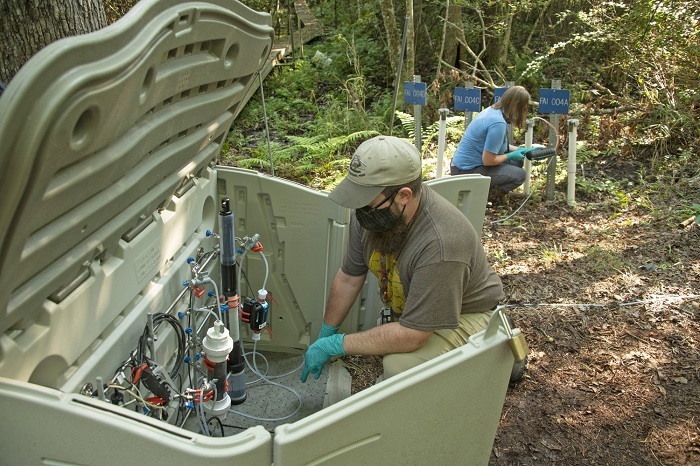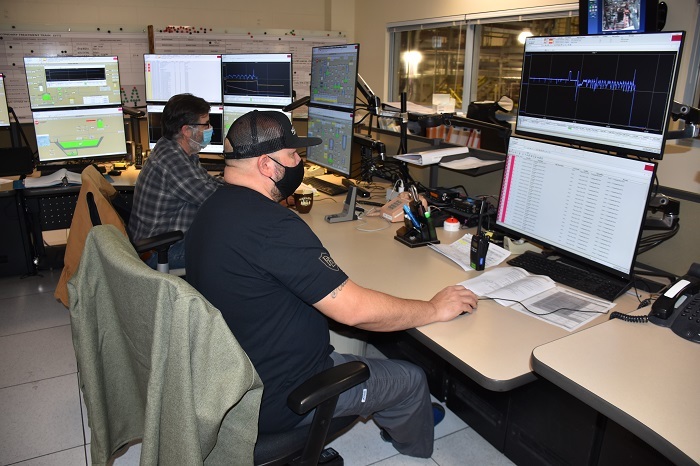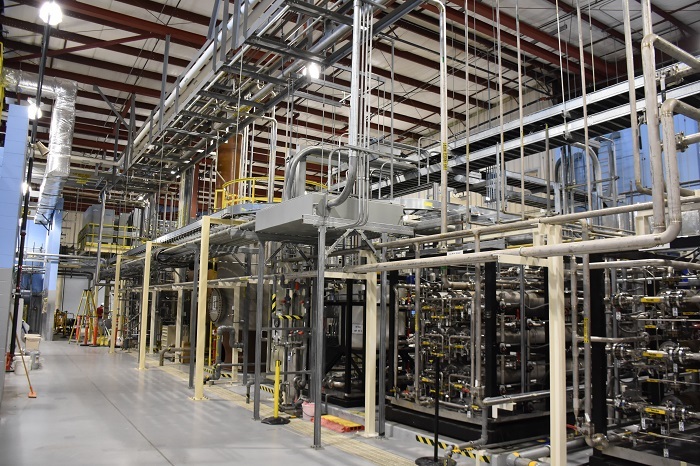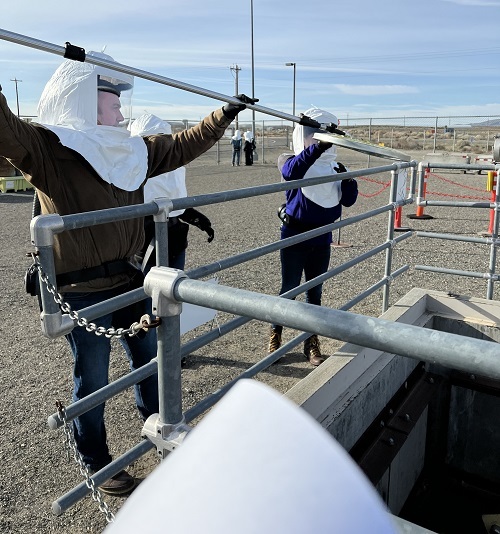 Savannah River Ecology Laboratory soil scientists Jeffrey Lott, left, and Christina Logan monitor experimental test equipment used to remove iodine-129 from groundwater at the Savannah River Site. The equipment is part of a one-of-a-kind system developed at the site for this study.
AIKEN, S.C. – EM has turned to a local laboratory to address a challenging contaminated groundwater plume that resulted from Cold War operations at the Savannah River Site (SRS).
“We have some of the most creative and innovative engineers and scientists in the world tackling these issues, and we’re asking them to apply their expertise and knowledge to this new task, working with the University of Georgia’s Savannah River Ecology Laboratory (SREL) to make it a reality,” said Jeff Thibault, an engineer with EM contractor Savannah River Nuclear Solutions (SRNS).
During the Cold War, wastewater containing trace amounts of radioactive iodine-129 was released to pond-like basins near two nuclear fuel processing facilities at SRS. The wastewater slowly migrated down through the soil and into the water table.
EM and SRNS have developed highly effective remediation techniques to treat a variety of chemical and radioactive contaminants at SRS, and many of these technologies have been adopted by other sites across the DOE complex. However, a new technique is needed for the latest groundwater contamination challenge.
“The cleanup technology currently used binds the iodine radionuclides to earthen sediment within the aquifer, effectively locking them into place,” Thibault said. “Unfortunately, that same technology can’t be used to treat the leading edge of the plume, which has reached a large marshy area at SRS. This presents a new cleanup challenge for us as the contamination surfaces in the marshlands.”
The goal is to identify a material that can be placed underground at the edge of the marsh, creating a permeable barrier to immobilize the iodine underground before it rises to the surface in the marsh.
“We want to create a solid treatment barrier that will allow the groundwater to pass through, but not the iodine-129,” he said.
John Seaman, a research professor at SREL, tested 11 promising materials for the permeable barrier. SREL scientists are working with SRNS engineers to test four of those materials in the field using contaminated water from the aquifer. The materials are zero-valent iron, porous iron composite, granular activated carbon and a mixture of iron and carbon.
“We hope to get positive results out of this first phase of testing. We also have funding in our budget for next year to test other sorbents or other combinations of sorbents,” said Thibault. “I’m very interested in the mixing of materials. Zero-valent iron may be good. But zero-valent iron with carbon may be fantastic.”
In addition to providing guidance and strategies for remediation technologies, SREL provides research expertise on wildlife ecology, disease ecology, biogeochemistry, and forestry and conservation.
-Contributor: DT Townsend
 This aerial photo shows the Effluent Treatment Facility, at left, and the four basins where wastewater from Hanford Site projects is stored before it is processed. Approximately 1 million gallons of wastewater are expected to be treated during the current campaign.
RICHLAND, Wash. – After another year of extensive equipment upgrades, EM Office of River Protection (ORP) tank operations contractor Washington River Protection Solutions (WRPS) is conducting its fiscal 2022 processing campaign at the Hanford Site’s Effluent Treatment Facility (ETF) with a goal to process approximately 1 million gallons of wastewater over the next few months.
The facility removes radioactive and hazardous contaminants from wastewater generated by tank waste activities, groundwater projects, solid waste disposal facilities and other Hanford cleanup activities.
“The resumption of facility operations is important to the Hanford Site cleanup mission,” said Bibek Tamang, ORP program manager. “Enhancements to the facility will also be critical to the success of Hanford’s tank waste treatment mission.”
 Washington River Protection Solutions nuclear chemical operators George Gilmour, back, and Clint Davidson, front, monitor readings in the Effluent Treatment Facility control room at the Hanford Site. After extensive equipment upgrades, the facility is conducting its fiscal 2022 wastewater processing campaign.
 The Effluent Treatment Facility is one of several Hanford Site facilities being upgraded to support tank waste treatment. The facility’s current wastewater treatment campaign will test new equipment to ensure it is ready to carry out its mission when 24/7 operations to treat tank waste begin.
The ETF is one of several Hanford facilities being upgraded to support the Direct-Feed Low-Activity Waste (DFLAW) Program for treating tank waste by immobilizing it in a glass form. When fully operational, Hanford’s Waste Treatment and Immobilization Plant will be the primary generator of liquid waste to be treated by the ETF.
“The upgrades and additions of some new equipment will increase the Effluent Treatment Facility’s capability, efficiency and reliability to handle the increase in wastewater volume,” said Tamang. “When working at full capacity, the Waste Treatment and Immobilization Plant is expected to produce as much as 5.4 million gallons of effluent per year that will need to be treated at the Effluent Treatment Facility.”
Annual wastewater treatment totals in the past have varied as Hanford cleanup work has progressed. The ETF processed 3.2 million gallons of wastewater during its last campaign, which ended in February 2021, and between 1 million and 4 million gallons in each of the three previous years.
“We will be seeing longer and larger processing campaigns when tank waste treatment begins,” said Brandon McFerran, ETF manager for WRPS. “Testing the new equipment and components during this year’s processing campaign will give us lessons learned for the years ahead.”
Since beginning operations in 1995, the facility has processed more than 330 million gallons of contaminated wastewater to remove radioactive and chemical waste.
This is the third year of renovations and modernization of the nearly 30-year-old facility. Once this year’s wastewater treatment campaign is completed, ETF will undergo a final round of improvements to accommodate future DFLAW needs.
-Contributor: Joan Lucas
Savannah River Remediation (SRR) engineers mentored University of South Carolina Aiken (USCA) engineering students for their capstone project. From left are USCA Associate Professor of Engineering Bethany Fralick Giles; USCA engineering student Shayn Price; USCA engineering student Melvin Green; SRR Melter Engineer John Owen; SRR Defense Waste Processing Facility and Saltstone Facility Chief Engineer Thomas Huff; USCA engineering student Tristan Harris; SRR Melter Engineer Dan Iverson; USCA engineering student Richard King; and SRR Melter Engineering Group Manager Kevin Brotherton.
AIKEN, S.C. – Savannah River Remediation (SRR), EM’s liquid waste contractor at the Savannah River Site (SRS), sponsored four University of South Carolina Aiken (USCA) engineering students for their science, technology, engineering, and math (STEM) capstone project.
“Partnering with the University of South Carolina Aiken extends the site’s involvement in the community and local institutions,” DOE-Savannah River Assistant Manager for Waste Disposition Jim Folk said. “Engaging engineering students with multi-discipline areas of design ensures interest in STEM-related careers at the Savannah River Site.”
SRR engineers Kevin Brotherton, Dan Iverson and John Owen, who work in the Defense Waste Processing Facility melter group, sponsored the students to share a glimpse of real-world engineering at SRS. The students’ project focused on the shielded canister transporter (SCT), a unique 18-foot-tall, 25-foot-long, 235,000-pound vehicle that performs high-level waste canister maneuvering activities.
“Our goal was to engage the students’ creative and critical thinking skills to develop realistic plans for improving the one-of-a-kind shielded canister transporter,” said Brotherton. “We proved that the knowledge learned in the classroom is directly applicable to real-world work at the Savannah River Site.”
 Four University of South Carolina Aiken engineering students focused on the shielded canister transporter, pictured here, for their science, technology, engineering, and math (STEM) capstone project at the Savannah River Site.
The SCT was designed and fabricated more than 30 years ago to operate until the conclusion of the site’s liquid-waste program. Throughout the years, SRR has improved its operability.
Using STEM principles, the students evaluated some of the SCT’s specifications, such as its diesel engines and hydraulic system, to devise ideas to improve the transporter’s efficiency and safety. Some ideas generated by the students included replacing all hydraulic tasks, like steering, with electric motors, which would decrease the time to ready the SCT for operation.
USCA engineering student Richard King participated in the capstone project and was fascinated to learn that when you look closely at the large and complex SCT, it was built with fairly simple parts.
“Before attending USCA, I was a dental lab technician in the U.S. Army. It was a difficult decision to choose to go to college full time instead of settling into my trade, but now it's easy to see that I made the right decision,” King said. “Making dentures was nice, but there's a whole other level of satisfaction that comes from working with talented engineers on a project like this.”
Brotherton, Iverson and Owen will continue to work with the students throughout the second semester of the capstone class, which began this month and focuses on detailed design ideas, including vendor and equipment suggestions.
-Contributor: Ashley Dernberger
Employees in supplied air equipment work through clues in an “escape room” during respiratory protection training at Hanford’s Volpentest HAMMER Federal Training Center.
RICHLAND, Wash. – A new respiratory protection course at the Hanford Site’s Volpentest HAMMER Federal Training Center features an “escape room” with an engaging twist: employees wear supplied air equipment while they answer questions, discover clues and solve puzzles in a simulated work environment.
They’re under pressure to “escape” or complete the activity safely in a limited amount of time before their air bottles empty. The simulation helps the employees learn the limitations, advantages and disadvantages of respiratory protection equipment.
Managed by EM Richland Operations Office (RL) contractor Hanford Mission Integration Solutions, HAMMER programs train Hanford workers in a range of skills through hands-on activities and real-life scenarios. HAMMER stands for Hazardous Materials Management and Emergency Response.
The center’s worker-trainers help develop and deliver many of the courses. Their skills and firsthand experience in the field make them knowledgeable and relatable to employees taking the courses.
“HAMMER worker-trainers are recognized as safety advocates by their peers, and they successfully bridge the gap between the field and classroom while providing advanced safety training,” said Angela Stoddard, RL program manager. “Their efforts to innovate educational methods also ensure a strong, consistent and continuously improving safety culture across the Hanford Site.”
 |
|
Employees in supplied air maneuver long-reach tools during an activity to simulate removing items from a pit. The training is conducted by Hanford’s Volpentest HAMMER Federal Training Center. |
Employees simulate pulling soil samples while wearing supplied air during a respiratory protection training at the Volpentest HAMMER Federal Training Center at the Hanford Site. |
|
 |
Another creative learning activity tests the ability to read and understand a respiratory protection form while under pressure from responding to simulated alarms. Employees also demonstrate equipment knowledge in responding to a simulated loss of air while wearing a supplied air respirator.
“HAMMER staff and worker-trainers frequently implement course improvements to meet the Hanford Site’s evolving training needs,” said Paul Vandervert, director of HAMMER. “Employee feedback on updates to the respiratory program course has been very positive.”
-Contributor: Robin Wojtanik
 A Waste Isolation Pilot Plant laboratories employee prepares to perform a test.
CARLSBAD, N.M. – EM’s Waste Isolation Pilot Plant (WIPP) laboratories were recently notified by the National Institute of Standards and Technology (NIST) that their latest round of sample testing data meets stringent criteria established to operate under the DOE Laboratory Accreditation Program (DOELAP).
“One of the requirements for DOELAP is that the WIPP laboratories must demonstrate annually their ability to analyze blind bioassay samples under a rigid set of criteria to maintain NIST compliance,” said Ginny Jones, manager of the WIPP laboratories.
WIPP laboratories analyze environmental samples such as water, air, soil and vegetation, as well as bioassay samples, such as urine. These samples are analyzed for all isotopes that may be present in transuranic waste sent to WIPP for disposal. Isotopes include plutonium, americium, uranium, cesium, cobalt and strontium.
In the latest bioassay samples, WIPP laboratories identified all isotopes of interest to WIPP and their associated activity levels. Essentially, this means the accuracy of the data produced by WIPP laboratories meets the stringent NIST requirements.
“Having the ability to analyze various isotopes at extremely low levels of activity helps WIPP demonstrate that our radiation protection protocols are working,” Jones said.
DOELAP accreditation is reviewed every three years by the DOE Office of Environment, Health, Safety and Security Office of Worker Safety and Health Policy. The process of submission for the program begins with the submittal of an application by a DOE facility that must be approved through the DOELAP committee.
The next accreditation opportunity will be spring 2022, which will mark WIPP’s seventh consecutive time to apply for the DOELAP. WIPP laboratories have maintained accreditation since 2000 and are among only a handful of laboratories in the country that maintain DOE’s lab bioassay accreditation.
-Contributor: Joy James-Foster
|